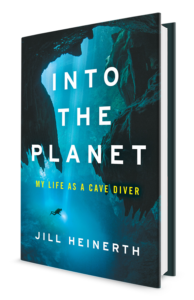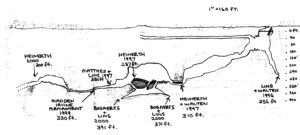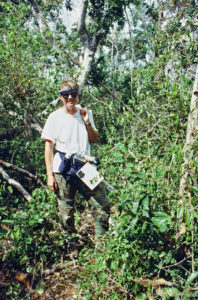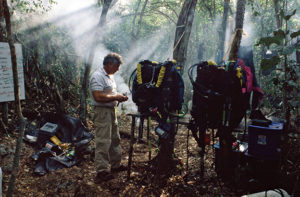 In 1997, my first husband Paul Heinerth and I discovered a remarkable deep cave attached to a little known sinkhole deep in the jungle of a region called the Ejido Jacinto Pat in Mexico. I shot the cover photo for Into The Planet at the spot where I later suffered from a severe case of decompression illness that nearly ended my career.
In 1997, my first husband Paul Heinerth and I discovered a remarkable deep cave attached to a little known sinkhole deep in the jungle of a region called the Ejido Jacinto Pat in Mexico. I shot the cover photo for Into The Planet at the spot where I later suffered from a severe case of decompression illness that nearly ended my career.
A year earlier, our friends, Dan Lins and Kay Walten had completed a long dive, entering at a cenote—pool in the jungle—called Tikim Ich. After a swim of over one-mile in highly decorated, snug passages, the floor and walls suddenly disappeared. They were in a water-filled room larger than anything they had ever encountered. Sun rays peeked through the thick jungle and penetrated the clear water, leaving them stunned with the magnificence of their find. Most known caves in Mexico’s Yucatan coastal region averaged 30-60 feet of depth. This sinkhole was a giant. They made a quick dive to plumb the hole and found it to be 246 feet deep. After their initial discovery, many individuals probed “The Pit” as they called it, and dove to investigate its depths. All examinations came to the same conclusion that the Pit was terminal and there was no continuing cave passage.

An early sketch I made of exploration at The Pit.
In 1997, Paul and I were visiting the Yucatan with friends and decided to take a look at The Pit. After following Kay and Dan’s original line and declaring their maximum depth reading as accurate, we continued to search the cenote. We had been asked by a colleague to bring back some rock samples for the University of Texas and a rough sketch map of the Pit. On traversing the mountainous debris cone in the center of the hole, we found a massive opening at 180 feet of depth. The great maw was over 80 feet wide and beckoned us deeper into the void. After that dive, we were eager to have a further look, but only had access to standard breathing air, a gas that would leave us with confusing drunkenness called nitrogen narcosis at those depths.

I’m hiking the trail to The Pit in 1997.
Paul and Kay and I were in awe of the size of the first room. It stretched for over 500 feet in length, and the floor to ceiling height was nearly 100 feet in places. The cave continued to drop deeper, and Paul tied off our survey line at 310 feet of depth (Divers: Of course, in today’s context a 300 foot deep dive on air is almost suicidal). We realized we needed to regroup and plan a mixed-gas dive. Our heads would be clearer if we could obtain helium for the next look. Two days later we were back in the jungle for one more dive using mixed gas. Paul and I with Kay and Gary Walten executed the most expensive dive of our lives (Non-divers: Helium is really expensive, especially in remote places). We determined that the Pit had excellent exploration potential, but we would need better technology to continue to explore. We needed to bring our rebreathers, which would re-circulate our breathing gas and scrub the deadly carbon dioxide from the breathing loop. This technology would economize the compressed gas costs and reduce the number of bailout tanks required for the dive. Given the enormous scope of the cave, we knew we would need underwater scooters to accelerate our swim in the deep tunnel.

Paul Heinerth preps his rebreather at The Pit in 2000.
I shot photos of the stunning environment using my Nikonos V underwater film camera, but the size of the cave was so enormous and the light so dim, that the long exposures came out blurry. As a creative professional, those images haunted me. I wanted to capture the essence of the cave to share with the world. My next exploration and photography efforts at The Pit nearly ended in tragedy. I suffered from debilitating decompression illness that threatened to sideline my entire career as an underwater cave explorer. But the beautiful image of sunlight cascading into the depths persisted in my mind.
Finally, in 2017, I returned to The Pit determined to get the shot that had been haunting me for 20 years. I nestled myself into the very location where I felt the first terrifying symptoms of decompression illness. I waited in the pocket in the ceiling, finding the right settings for my photo. Then, as if on cue, a single ghostly diver descended into the wispy murk obscuring the debris mound—that place where one can transition down through the fog to find the deep cave below. It was as if I was seeing myself touching the void and preparing to make a life-changing plunge into the deep cave. I fired the shutter on my camera knowing that I had just captured the cover image for Into The Planet.
If you want to read more about The Pit and how I survived a close brush with my mortality, please pre-order a copy of Into The Planet, to be released on August 27, 2019, online and through booksellers everywhere.
